Just announced is the Sony Cyber-shot DSC-RX10 III or Sony RX10 III for short. It is no direct replacement for last year’s Sony RX10 II which at first glance looks very similar. They are essentially the same camera featuring the same video recording features. The real change comes with the incorporation of a monster zoom lens made by Carl Zeiss with a 24 -600mm FF equivalent compared to the now paltry 24-200mm FF equivalent of the RX10 II.
The lens is impressive for a super zoom camera capable of 25x zoom range. Wide end of 24mm has an aperture of f2.4 with the Tele end closing to f4 which is still pretty respectable for such reach. It has stabilization also which Sony claims 4.5 stops worth of handhold-ability which seems the best case scenario.
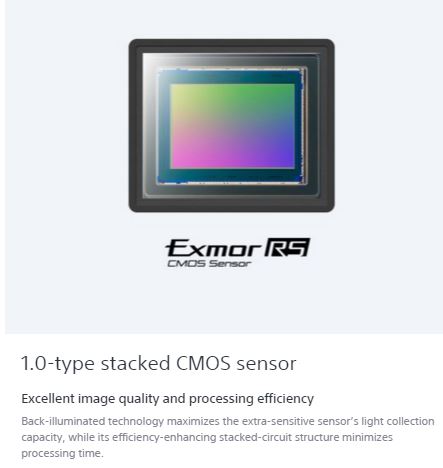
MOVIE RECORDING MODE (NTSC):
AVCHD: 28M PS (1,920 x 1,080/60p) / 24M FX (1,920 x 1,080/60i) / 17M FH (1,920 x 1,080/60i) / 24M FX (1,920 x 1,080/24p) / 17M FH (1,920 x 1,080/24p),
XAVC S 4K: 30p 100M (3,840 × 2,160/30p) / 30p 60M (3,840 × 2,160/30p) / 24p 100M (3,840 × 2,160/24p) / 24p 60M (3,840 × 2,160/24p),
XAVC S HD: 60p 50M (1,920 × 1,080/60p) / 30p 50M (1,920 × 1,080/30p) / 24p 50M (1,920 × 1,080/24p) / 120p 100M (1,920 × 1,080/120p) / 120p 60M (1,920 × 1,080/120p), MP4: 28M (1,920 x 1,080/60p) / 16M (1,920 x 1,080/30p) / 6M (1,280 x 720/30p)
MOVIE RECORDING MODE (PAL):
AVCHD: 28M PS (1,920 x 1,080/50p) / 24M FX (1,920 x 1,080/50i) / 17M FH (1,920 x 1,080/50i) / 24M FX (1,920 x 1,080/25p) / 17M FH (1,920 x 1,080/25p),
XAVC S 4K: 25p 100M (3,840 x 2,160/25p) / 25p 60M (3,840 x 2,160/25p),
XAVC S HD: 50p 50M (1,920 x 1,080/50p) / 25p 50M (1,920 x 1,080/25p) / 100p 100M (1,920 x 1,080/100p) / 100p 60M (1,920 x 1,080/100p), MP4: 28M (1,920 x 1,080/50p) / 16M (1,920 x 1,080/25p) / 6M (1,280 x 720/25p)
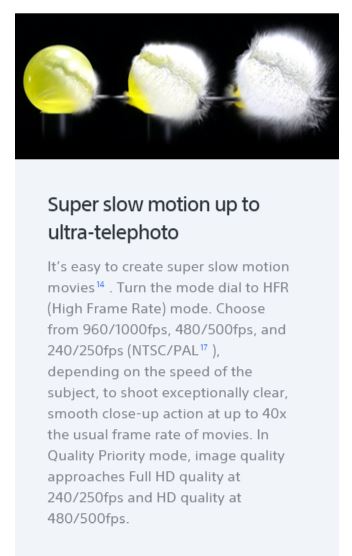
HFR Mode (High Frame Rate)
NTSC: XAVC S HD: 60p 50M (1,920 x 1,080/240fps), 60p 50M (1,920 × 1,080/480fps), 60p 50M (1,920 × 1,080/960fps) / 30p 50M (1,920 × 1,080/240fps), 30p 50M (1,920 × 1,080/480fps), 30p 50M (1,920 × 1,080/960fps) / 24p 50M (1,920 × 1,080/240fps), 24p 50M (1,920 × 1,080/480fps), 24p 50M (1,920 × 1,080/960fps)
Sensor Readout Number of Effective Pixels:
Quality Priority: 240fps / 250fps (1,824 × 1,026), 480fps / 500fps (1,676 × 566), 960fps / 1000fps (1,136 × 384) /
Shoot Time Priority: 240fps / 250fps (1,676 × 566), 480fps / 500fps (1,136 × 384), 960fps / 1000fps (800 × 270), PAL: XAVC S HD: 50p 50M (1,920 × 1,080/250fps), 50p 50M (1,920 × 1,080/500fps), 50p 50M (1,920 × 1,080/1000fps) / 25p 50M (1,920 × 1,080/250fps), 25p 50M (1,920 × 1,080/500fps), 25p 50M (1,920 × 1,080/1000fps)
HSC- There is no change in Slow motion specs. Resolutions are exactly the same as last year’s RX100 IV and RX10 II cameras in HFR mode “Which are some of the best out there”. It is unclear however if the recording times are the same of 2 seconds at Quality Priority or 4 Seconds at Recording time priority. We have to make a guess as there is no information from Sony and or other sources that really can confirm this. All features being mostly a carbon copy; we estimate that the rec times are the same as the limited ones in the RX10 II. This has been the biggest gripe among RX camera owners; if recording time in HFR mode is improved we will let you know but somehow we are not betting on that feature being enhanced.
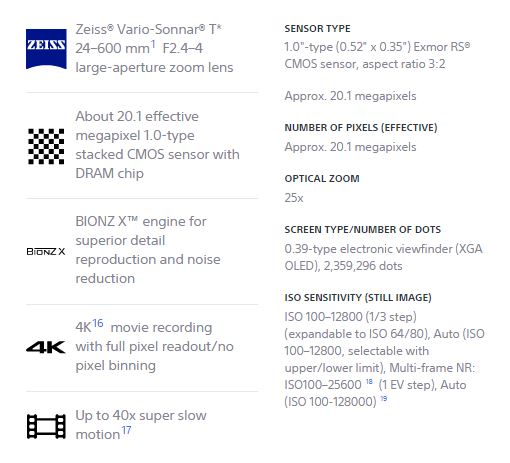
Lens Specs:
LENS TYPE: Zeiss® Vario-Sonnar® T* Lens, 18 elements in 13 groups (6 aspheric elements, including AA lens)
F-NUMBER (MAXIMUM APERTURE)F2.4 (W)–4.0 (T)
IRIS DIAPHRAGM 9 blades
FOCAL LENGTH (F=)f = 8.8–220 mm 24mm-600mm FF Equivalent.
FOCAL LENGTH (F=) 35MM FORMAT EQUIVALENT:
[Still image 3:2] f = 24–600 mm [Still image 16:9] f = 26–630 mm [Still image 1:1] f = 31–760 mm [Still image 4:3] f = 27–650 mm [Movie 16:9] f = 26–630 mm (SteadyShot Standard), f = 27–890 mm (SteadyShot Active), f = 30–910 mm (SteadyShot Intelligent Active), [Movie 4K 16:9] f = 28–680 mm (SteadyShot Standard),
[HFR 960fps] f = 42–990 mm (Quality Priority), f = 60–1390 mm (Shoot Time Priority),
[HFR 480fps] f = 28–680 mm (Quality Priority), f = 42–990 mm (Shoot Time Priority),
[HFR 240fps] f = 26–630 mm (Quality Priority), f = 28–680 mm (Shoot Time Priority)
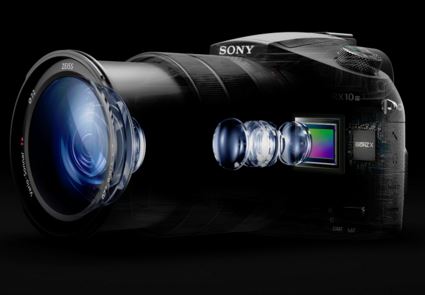
HSC- Note how the focal length changes as speed is increased. This is due to line skipping on the sensor and windowing which crops the image further to get to the higher frame rates.
What else is new?
The lens is the big new feature here however there have been a few improvements that really have some needed features for video and photo enthusiasts.
A new high-contrast XGA OLED Tru-Finder™ with close to 2.35 million pixels make the viewfinder which offers better visual aspects.
The other great feature is three rings in the lens barrel system. Three Independent Zoom, Focus and Aperture rings will make video users very happy. Although the fly by wire electronic aspect could pose problems for focus pulling.
Price?
The new Sony RX10 III camera will be $200 dollars more expensive than the current RX10 Mark II “$1,298” which at $1,498.00 USD is not cheap for a fixed lens super zoom camera. While it is a little rich for a consumer camera; it is of note the capabilities and lens included are unrivaled in the 1″ sensor market. This capability doesn’t come cheap. It would be good if the older RX cameras had their prices slashed with the announcement, but that is still not a reality today.
If you were waiting for the all around do it all travel camera, this might be what you were looking for.
Slow Motion & HFR Video Samples by Sony on the RX100 III:
https://www.youtube.com/watch?v=i_nNfNcdBOY
4k Video Sample, Great Super Sampling quality:
Availability:
The Sony RX10 III will be available for $1498 USD starting in May this year, with a pre-order date of mid-April. We will keep you informed of pre-ordering dates and more data on the camera. Thanks for reading!
Sony RX Cameras Available today with the same slow motion features at the same quality:

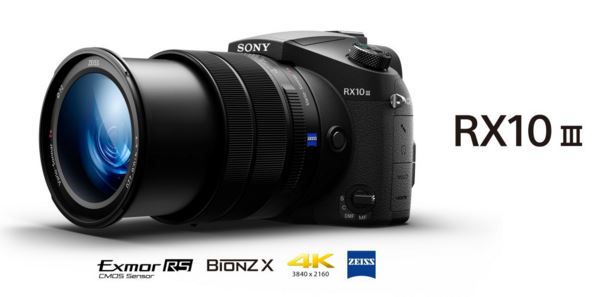
For that price, they could’ve at least made the HFR a little better. Not necessarily higher frame rates but better quality with current frame rates such as less aliasing and moire. It wouldn’t have hurt either if they upped the Quality Priority setting to 4 or 5 seconds. What do you think?
They are using the same chip and software, only the lens has been improved. The next generation will probably have more memory and rec time. Maybe end of year. Its still a great camera for the price.
Most slow motion capture events are not longer than the 2 sec. most are much slower. Remember that is 80 seconds at normal speed the high speed expands time to. Remember each frame is 1/1000 of a second period of real time.
The memory is expensive and would drive up the price.
The ability to capture the time before the triggering point is hugely useful, and likely the mode most used.
Do I missed something? where is the 120fps?
600x is good news for people who like to take photo of birds…
120p is listed in the NTSC video specs. It is not part of HFR mode as 120fps 1080p can record continuously without the 2 sec or 4 sec time limit. Yes 600mm is great reach with good light gathering at F4. A Canon 600mm F4 for example is extremely expensive and weights a ton.
how can we record video in continues slow motion
The camera can record 60fps, 120fps Full HD in continuous mode and at limited duration 2 or 4 seconds at 240fps, 480fps and 960fps.
Carl Zeiss died in 1888, so it’s a pretty sure bet the lens was not actually made by him… the Carl Zeiss AG company / corporation perhaps… 😉
Anyway, joking aside, the big downer for video users of these RX10 MK 2 / 3 cameras is that while there is a switch to de-click the aperture ring, this does NOT in fact make the aperture step-less. Adjusting the aperture causes 1/3 or 1/2 stop jumps (depending on setting) in the brightness of your video.
Very disappointed Sony overlooked this important aspect of video shooting, considering how much they promote the camera for video.
Interesting observation, this is common on electronic aperture lenses as the aperture is a slave to the demands of the stepper motors. It would be great if it was a continuous fluid physical ring but we can’t get it all can we? It is still a great camera that while a bit overpriced at the moment it will be more attractive once end of year discounts approach.
Any thoughts on how to shoot a slow motion of a total solar eclipse (August 2017) with the rx10 iii?
Hi, for the solar eclipse you want a frame rate maximum of 120fps because the event takes several minutes to play out. Super slow motion is best used for events that are only a few seconds sometimes under 1 second long in real time. The eclipse could be shot at 120fps with the appropriate filters or solar telescope to bring out the best of the corona. We are very excited about the upcoming eclipse but will only see a partial due to our latitude. At 120fps you can have enough frames to see detail of flairs if possible. However the Sun would love resolution more than frame rate. We have a solar coronado PST and 4k does work much better to capture the corona filaments. If your camera shoots 4k at 30p or 60p then that is what we would use. On a stable mount or one that tracks the sun you will be recording an amazing event. Keep us posted on your method and good luck + clear skies!
As it is from the shutdown in PAL at 100FPS. What is the minimum closure?
Are you asking minimum aperture or shutter speed? The Maximum shutter speed of the camera is 1/32000.